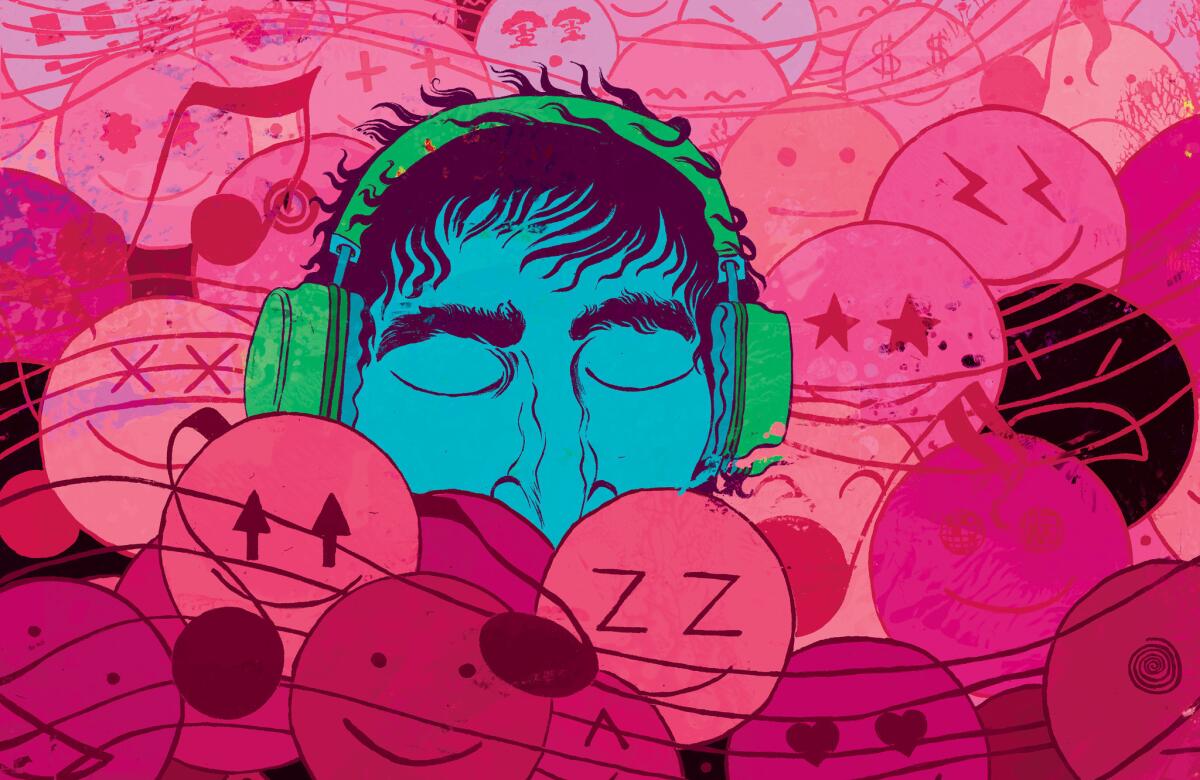Music streaming services unleash a torrent of digital playlists

- Share via
It’s a question we pose daily, and with increasing frequency in an age of digital bounty and instant entertainment: “What am I in the mood for?” We ask it of office mates at lunch, friends before taking in a movie, with family on weekends. We stare at the search window in iTunes, dumbfounded, and wonder.
When sitting before the television, no longer flipping a finite number of channels or abiding programmer timelines, we ponder myriad services and platforms and then utter to ourself or significant other, “What are you in the mood for?” Movie, TV series or webisode? Drama, comedy, action/adventure or foreign film? Tethered or untethered? Time Warner? Apple TV? DirectTV? Amazon Prime, Google/YouTube or Netflix recommendation? Hulu Plus? iPad app?
Yikes. Maybe let’s just play “Two Dots” on the Samsung Galaxy X5?
No. Let’s read and listen to music. Kindle or analog? Vinyl, disc, MP3 or stream? New bestseller, old unread download or public domain Mark Twain? The stack of unread New Yorkers is over there, mixed in with the newspapers. The pile of books by the bed is too intimidating.
Dine in or out? What are you in the mood for? Check The Times, Yelp, Open Table, Google Maps, EAT24 and/or Zagat. Will we drive or use Uber? What are we going to listen to in the car? FM, CD, SiriusXM or iTunes iPhone dock? If the latter, podcast, MP3 library or Pandora?
The gaping digital abyss stares back, inducing anxiety where pleasure should be. Maybe some relaxation music could help. But, um, what are you in the mood for?
Few answers are more crucial to the success of music streaming services than the puzzle of navigating the infinite jukebox, where unlimited choice stirs a special brand of overwhelmed malaise. We open iTunes and a decade’s worth of MP3s await on various hard drives, existing as lines of text on a screen and lacking any emotional allure. We launch platforms and ask, what do I want to hear?
In doing so, for a brief moment we reflect. Loud, soft, old, new? Sad or happy? Lennon or McCartney? (Harrison!) Vocal or instrumental, intense or subdued? Rhythmic thump, distortion, anger? Or aural salve, warm with calm tones, space and easy melodies?
Other than solving the huge problem of fair compensation for musicians, the key question facing Beats Music, Pandora, Spotify, Rhapsody, Rdio and others is how to rein in the confusion. All are committing much time and online real estate to exploring new avenues of doing so, many of which tap into our desire for music that reflects, enhances or adjusts how we’re feeling. Through mood-based playlists that compile sounds from across eras, companies are in a race to see who can best connect with a listener’s current emotional state, activity or life circumstance.
In the answer lies profits, and if recent corporate transactions are any indication, billions of dollars await the service that finds a solution. In May, Apple bought headphone maker and music streaming service Beats Entertainment for $3 billion; its Beats Music service boasts of its thousands of hand-curated playlists. Its creative officer is Trent Reznor.
Last month Google acquired Songza, the mood-based platform that has earned devotees because of its ability to generate lists based on activity and time of day. Its pitch: “Listen to music curated by music experts.” Amazon’s recently launched Prime Music streaming service offers a far smaller library but compensates by a similar volume of lifestyle playlists.
All boast of being “curated,” a buzzword that suggests a faculty’s worth of contemplative aesthetes scouring archives — instead of mostly uncredited humans wearing bass-heavy Beats headphones and dragging and dropping a quota’s worth of tracks into another “Beards & Baristas” mix. Regardless of environment, each new collection adds a touch more nuance to the whole, tailored especially for you, here, now.
Getting up before dawn? Spotify has your soundtrack in “Early Morning Rise,” 25 tracks offered because “You need a perfect set of songs when the day starts off early.” Decompressing after a rough day? “Take a deep breath. Relax. And let all the tension go” with Decompression, a list of soft electro-acoustic tracks by Aphex Twin, Jack Johnson, Royksopp, Daft Punk and Alexandre Desplat. Its “Coffee Shop Indie” features songs designed for “a latte, your laptop, and lots of sweet tunes from Foxygen, Alt-J and more.”
Bloated? Spotify’s “The PMS Playlist” submits that the 90 minutes of “songs that you need to hear those days when you can not stop crying, eating or yelling at the ones who deserve it the least” will include TLC’s “No Scrubs,” Pink’s “Just Like a Pill” and “Cigarettes and Chocolate Milk” by Rufus Wainwright. Staring at the existential abyss? “The Cure for Loneliness” may either save or ruin you with tracks by John Mayer and Katy Perry, Coldplay, Cults and Hot Chelle Rae.
Beats Music doesn’t yet track menstrual cycles in its own playlist-generating conceit, called “The Sentence,” which offers lists based on current activity, time of day and mood. Hundreds of them lie in wait, generated by a combination of humans and algorithms looking to capture just the right emotion. In a sense, the playlists seek to occupy space formerly held by Muzak, while at the same time touting selectors as knowledgeable as record store clerks.
On first blush, the instinct from a critic’s perspective is to wonder who listens to music in this manner? One of the joys of listening is matching moments and sounds, finding the exact right piece for the exact right feeling — my right piece could well be quite different than yours. That doesn’t necessarily mean that when I’m sad I want to listen to Nick Drake. Sometimes when I’m in a state of pure bliss I want to hear Billie Holiday’s version of “Strange Fruit,” or some deep country blues. It fills me with wonder and a certain brand of joy, these song of devastation. I didn’t realize there was a feeling like Lonnie Holley’s “Keeping a Record of It” or Kanye West’s “New Slaves” until I heard them. Joni Mitchell’s “Blue” is its own mood.
But, then, I’m an active listener and extremely attuned to sound. I’d cancel a dinner party before allowing the soundtrack to be Spotify’s “Dinner with Friends” playlist, which features music by Phil Collins, Sting, Ed Sheeran, Mariah Carey and Jack Johnson. When I’m drinking coffee, the last place I’m looking is on Spotify’s “Your Favorite Coffeehouse” selections (Iron & Wine, Civil Wars, Parachute, Nick Drake, Del Amitri).
These playlists aren’t for me, nor are they intended to be. Companies have mostly secured the devotion or derision of us active-listening geeks. Instead, they’re designed to attract the silent majority of casual listeners for whom thinking about music is akin to me pondering the horsepower of a 1972 El Camino. To succeed, Beats, Songza and Pandora don’t merely need a bigger slice of the pie. They need to make the pie bigger by convincing those once content to tune to a favorite FM station and endure the ads or pledge drives or set the cable box to Time Warner’s music channels that they should spend money on music when they seldom have.
Whether effective or not is to be determined, but 272,361 followers of Spotify’s “House Workout” can’t be ignored (Calvin Harris, Tiesto, Die Antwoord, etc.). Unless you prefer sweating to Amazon Prime Music’s “Hip Hop Workout [Explicit],” which opens with Waka Flocka Flame’s “Flex,” peaks with Mobb Deep’s “Survival of the Fittest” and winds down on Wale’s “Ambition.” Songza’s “Thrash Metal Shred” muscles-up with Megadeth, Kreator and Overkill.
Used properly, a whole chunk of these lists can be of great utility for those of us looking to keep up, regardless of whether we’re too snobby to let others do the picking. Most major services offer lots of “new releases” lists, divided by genre, that help to draw boundaries around the hundreds of hours of music released weekly. Songza’s “Brand New Music” folder offers lists of new hits, critical darlings, online superstars and “blogged favorites.” Lazify, a Spotify app designed for “lazy listeners,” has great taste: type in an artist, however obscure, and it picks excellent like-minded jams.
Dealing with chemically induced laziness? Songza’s got dozens of lists designed for getting high on the couch, among them “Stoned in the Park,” “Mushroom Skies,” “Trippy Weekend at the Cabin” and “Analog Haze.”
Enough already? There’s a playlist for that, too. Called “White Noise,” which invites its listeners to experience “the soothing hum of 20+ hours of continuous white, pink and blue noise.” Sign me up.
More to Read
The biggest entertainment stories
Get our big stories about Hollywood, film, television, music, arts, culture and more right in your inbox as soon as they publish.
You may occasionally receive promotional content from the Los Angeles Times.











